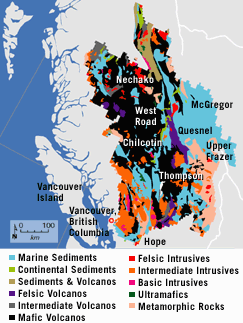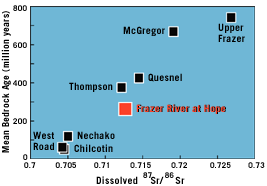
|
 |
Science Highlights > River Chemistry as Geologic Clock
River Chemistry as Geologic Clock
 |

|
|
Digital bedrock maps show the distribution and age of different types of rock in Canada’s Frazer River Basin (above). Peucker-Ehrenbrink’s first-of-its-kind analysis reveals a linear relationship between the mean age of the bedrock and the isotopic composition of the Frazer River tributaries (below). The findings illuminate the interrelationship between continental geology and ocean chemistry. (Geologic Survey of Canada for the bedrock data; Wheeler et al. [1997],
and the World Resources Institute for the Fraser watershed outlines;
Revenga et al., [1998]; Cameron and Hattori [1996] for the Sr-isotope data)
|

|
Associate Scientist Bernhard Peucker-Ehrenbrink had what he calls a simple idea: to estimate the chemistry of the world’s rivers without ever leaving his lab.
A geochemist, Peucker-Ehrenbrink studies the chemical composition of oceans and rivers, a major source of dissolved elements in seawater. Knowing that river chemistry is strongly influenced by the interaction of rainwater with soils and bedrock, he reasoned that he could use data on river basin bedrock and how different bedrock weathers to estimate river chemistry. Conveniently, the data were readily available as digital bedrock plots, maps of river basins, and well-documented measurements of naturally occurring strontium isotopes in rivers. (Strontium is a kind of natural clock, with strontium-87, a stable decay
product, causing 87Sr/86Sr to increase with age.)
Overlaying bedrock plots with maps of river basins (which, in the case of the Mississippi River, can cover nearly a third of the continental US), Peucker-Ehrenbrink began by computing the abundance and age of bedrock in 14 large river basins. He then compared the mean age of the bedrock in different river basins with the known isotopic composition of strontium in the rivers.
He found a surprisingly clear correlation between the isotopic composition of dissolved strontium and the mean age of bedrock. As bedrock age increased, so too did 87Sr/86Sr. This linear correlation held true for the Frazer River in British Columbia (above right), and, in the US, for the Mississippi, Susquehanna, and the Brazos rivers.
The database is the first of its kind and opens up many possibilities for future research. Not only will it help clarify aspects of today’s seawater chemistry, but Peucker-Ehrenbrink believes the analysis can also be applied to reconstructions of global bedrock distribution in the past to explain past changes in seawater chemistry. This work was funded by the National Science Foundation.
|
|
 |
|
